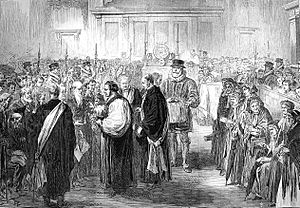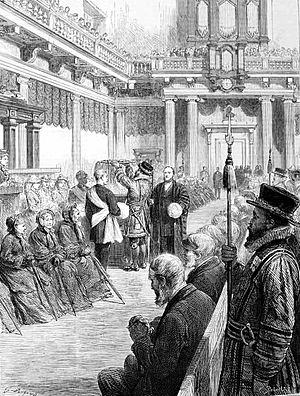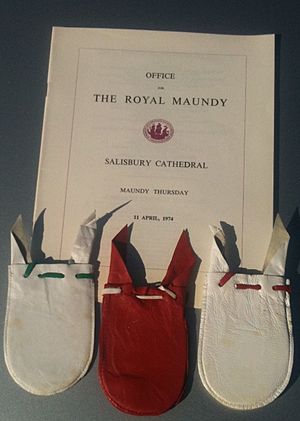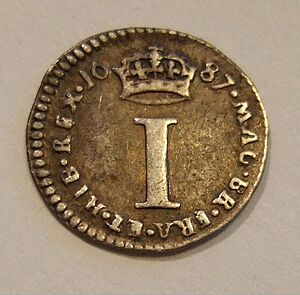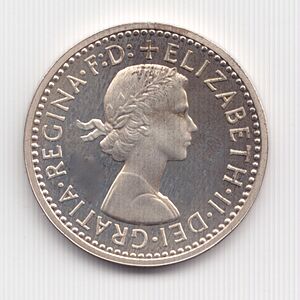Royal Maundy facts for kids
Royal Maundy is a special religious service in the Church of England. It happens on Maundy Thursday, which is the day before Good Friday. During this service, the British monarch (like the King or Queen) or a royal helper gives out small silver coins. These coins are called "Maundy money". They are given as gifts to older people.
The word "Maundy" comes from a Latin word, mandatum, which means "command". This refers to a command Jesus Christ gave at the Last Supper. He told his followers to love each other. Long ago, English monarchs would even wash the feet of poor people, just like Jesus did. They also gave gifts and money to those in need. Over time, the gifts of clothing and food were replaced with more money.
For many years, the monarch didn't go to the service, sending an official instead. But in 1932, King George V started a new tradition by attending. Now, the service is held in a different church or cathedral each year, not just in London. Queen Elizabeth II almost always went to the service during her long reign. Today, people are chosen to receive Maundy money because they have helped their churches or communities.
The Maundy money coins come in special amounts: one penny, two pence, three pence, and four pence. These coins are made of silver and are usually kept by collectors because they are special. The coins have the reigning monarch's picture on one side. The other side has a crown and a number, which has looked almost the same since 1822. The coins are given in two leather bags: a white one and a red one. The white bag holds coins that add up to the monarch's age in pence. The red bag holds a £5 coin and a 50p coin.
Contents
The Story Behind Maundy
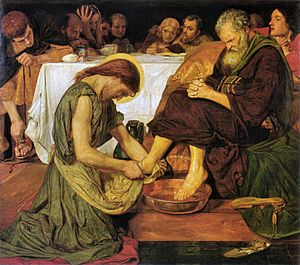
The word Maundy comes from the Latin word mandatum, meaning "command". This command was given by Jesus Christ. The Bible tells us that the night before he was crucified, Jesus ate a meal with his disciples. After the meal, he washed their feet. He told them, "If I then, your Lord and Master, have washed your feet, ye also ought to wash one another's feet." This act of washing feet and the command to love each other led to the Royal Maundy service.
By the 4th or 5th century, a ceremony of washing the feet of the poor had become a tradition in the Roman Catholic Church. This ceremony was called the pedilavium.
Early English Maundy Services
The first English king known to give gifts at a Maundy service was King John in 1210. He gave clothes, food, and other items to the poor. In 1213, he also gave small silver coins. He gave 13 pence to each of 13 poor men. The number 13 was important because it represented the Twelve Apostles plus Jesus.
Over time, the Maundy service became a big event for royal families across Europe. By 1363, Edward III gave 50 pence to 50 poor men, matching his age. Later, King Henry IV made it a rule that the number of pence given should match the monarch's age.
Even though Mary I and Elizabeth I had different religious beliefs, both held grand Maundy ceremonies. In 1556, Queen Mary washed the feet of 41 poor women, matching her age. She also gave them 41 pence each, plus bread, fish, and clothes. Queen Elizabeth I later changed the gift of her own gown to a sum of £1 to avoid people fighting over it.
If there was a serious illness like the plague, the monarch would not attend. An official, usually the Lord High Almoner, would go instead. Even though sweet-smelling flowers called nosegays were used to cover any bad smells, the feet were washed three times before the monarch did the pedilavium. Nosegays are still carried today as part of the tradition.
Maundy After the Restoration
King Charles I rarely went to the Royal Maundy service. After he was restored to the throne, his son Charles II attended often. He wanted to be popular with the people. Charles II even went during years when there was a plague.
Most sources say that King James II was the last monarch to personally wash the feet of the poor in 1685. After 1698, there are no records of a monarch attending the service again until 1932. The Lord High Almoner continued to perform the foot washing until 1737. Today, the only reminders of the foot washing are the nosegays and the special linen towels worn by some officials.
The service was usually held near London. In medieval times, it moved with the monarch. In 1714, it moved to the Chapel Royal in Whitehall. Then, in 1890, it moved to Westminster Abbey. Since 1954, the service has often been held outside London.
The number of people receiving gifts continued to match the monarch's age. Since the time of King George I (1714–1727), both men and women have received gifts. Each person receives the same number of pence as the monarch's age.
The gift of clothing for women was stopped in 1724. This was because the women would immediately try on the clothes and swap them, which was seen as improper in a church. Instead, they were given money. Men continued to receive cloth until 1883. Then, officials realized that many poor recipients were selling the cloth instead of making clothes. So, men also started receiving money instead.
In 1837, King William IV ordered that the food gifts be replaced with money. This was because recipients were selling the food for much less than it was worth. This amount of money is still given today.
An article from 1843 described a Maundy ceremony. It mentioned that poor men and women, matching the Queen's age, attended church. They received bread, meat, and fish in wooden bowls. Officials carried bouquets of flowers and silver trays with red and white leather bags. The red bags held a sovereign coin, and the white bags held the Maundy money. The recipients also received cloth, linen, and shoes. They would drink the Queen's health from a small cup.
In the early 20th century, some members of the royal family attended. But it was Princess Marie Louise who suggested in 1931 that her cousin, King George V, should give out the gifts. He did so in 1932, starting a new royal tradition. George VI also attended, and Queen Elizabeth II was only absent five times during her very long reign. In 2022, Prince Charles (now King Charles III) and Camilla, Duchess of Cornwall stood in for her.
Since 1957, recipients attend the service only once. This was changed because the service started moving to different cities. Before that, a recipient could attend for life.
Royal Maundy Today
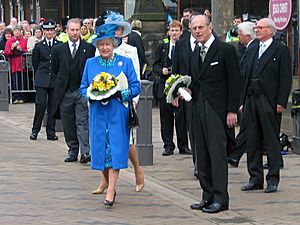
Queen Elizabeth II saw the Maundy service as a very important part of her royal duties. It was one of the few times she traveled to give awards to people. The service now moves around the country, visiting different cathedrals. Queen Elizabeth decided that the service should only be held in London about once every ten years.
The ceremony has only been held outside England twice. Once in Wales in 1982, and once in Northern Ireland in 2008. By 2017, every Anglican cathedral in England had hosted the Royal Maundy.
The services in 2020 and 2021 were cancelled because of the COVID-19 pandemic. The gifts were sent to the chosen recipients by mail. King Charles III held his first Maundy service as king in 2023 at York Minster, with Queen Camilla by his side.
Today, the recipients are older people chosen from different Christian churches. They are recognized for their service to their churches and communities. Usually, they live in the area where the service is held.
Who Attends the Ceremony?
The Yeoman of the Guard are present at the ceremony. They act as "Indoor Guard". The choir of the Chapel Royal also sings. Six "wandsmen" help guide the recipients to their places.
There are also four "Maundy Children" present. These are two boys and two girls. Long ago, the Maundy Children were actually four old men. But in 1808, they were replaced by real children. Today, the Maundy Children are chosen from schools. They receive a set of Maundy coins for being part of the service. Officials at the service wear special linen towels over their clothes. These towels have been used for many years.
Since 1968, a company called Barrow Hepburn and Gale has made the traditional white and red leather purses. Until 1979, the Queen gave two separate distributions of money. Now, the gifts are combined. Recipients receive two purses in one go. The white purse contains the special Maundy coins. The red purse contains the other money, which is £5.50. This amount includes money for the monarch's gown, clothing, and food that were once given. For example, in 2015, the £5.50 included a £5 coin honoring Winston Churchill and a 50p coin for the Battle of Britain.
One man and one woman are chosen for each year the monarch has lived. They receive Maundy money equal to that number of pence. Before the service, recipients attend a "Maundy Lecture" to learn what will happen. The cathedral becomes a "Royal Chapel" for the day, and the Royal Standard flag flies.
The purses are carried into the church by the Yeomen on silver dishes held above their heads. This tradition might come from when food was given out. Some think it was to stop people from grabbing the food too early. Others believe it was to prevent the smell of fish from bothering the congregation.
The Service Itself
The Royal Maundy service is quite simple. It begins with a reading from the Bible (John 13:34), which includes Jesus's "command" (mandatum). There are two main readings. The first (John 13) also talks about the command. The second reading describes the Last Judgment. The monarch gives out half of the gifts after the first reading and the other half after the second.
Anthems are sung by the Chapel Royal choir and the local choir. The service ends with George Frideric Handel's famous song Zadok the Priest. There are also prayers, "God Save the King", and a blessing. Two hymns are sung, but there is no sermon.
Six silver dishes are used to hold the gifts. One of these, the traditional Maundy Dish, is part of the Royal Regalia and is kept at the Tower of London when not in use. All six dishes are very old, dating back to the time of Charles II. The Yeomen hold these dishes as the monarch walks around, greeting people and giving them their gifts.
The monarch often chats informally with the recipients. Some recipients have even given gifts back, like a jar of marmalade to Queen Elizabeth II. One recipient, Mercia Tapsell, described her experience in 1992 as "out of this world". She loved hearing Zadok the Priest and seeing the Queen smile at her.
Places Where Royal Maundy Has Been Held (Since 1952)
- 1952: Westminster Abbey, London
- 1953: St Paul's Cathedral, London
- 1954: Westminster Abbey
- 1955: Southwark Cathedral, London
- 1956: Westminster Abbey
- 1957: St Albans Cathedral
- 1958: Westminster Abbey
- 1959: St George's Chapel, Windsor Castle
- 1960: Westminster Abbey
- 1961: Rochester Cathedral
- 1962: Westminster Abbey
- 1963: Chelmsford Cathedral
- 1964: Westminster Abbey
- 1965: Canterbury Cathedral
- 1966: Westminster Abbey
- 1967: Durham Cathedral
- 1968: Westminster Abbey
- 1969: Selby Abbey
- 1970: Westminster Abbey
- 1971: Tewkesbury Abbey
- 1972: York Minster
- 1973: Westminster Abbey
- 1974: Salisbury Cathedral
- 1975: Peterborough Cathedral
- 1976: Hereford Cathedral
- 1977: Westminster Abbey
- 1978: Carlisle Cathedral
- 1979: Winchester Cathedral
- 1980: Worcester Cathedral
- 1981: Westminster Abbey
- 1982: St David's Cathedral
- 1983: Exeter Cathedral
- 1984: Southwell Minster
- 1985: Ripon Cathedral
- 1986: Chichester Cathedral
- 1987: Ely Cathedral
- 1988: Lichfield Cathedral
- 1989: St Philip's Cathedral, Birmingham
- 1990: Newcastle Cathedral
- 1991: Westminster Abbey
- 1992: Chester Cathedral
- 1993: Wells Cathedral
- 1994: Truro Cathedral
- 1995: Coventry Cathedral
- 1996: Norwich Cathedral
- 1997: Bradford Cathedral
- 1998: Portsmouth Cathedral
- 1999: Bristol Cathedral
- 2000: Lincoln Cathedral
- 2001: Westminster Abbey
- 2002: Canterbury Cathedral
- 2003: Gloucester Cathedral
- 2004: Liverpool Cathedral
- 2005: Wakefield Cathedral
- 2006: Guildford Cathedral
- 2007: Manchester Cathedral
- 2008: St Patrick's Cathedral, Armagh
- 2009: Bury St Edmunds Cathedral
- 2010: Derby Cathedral
- 2011: Westminster Abbey
- 2012: York Minster
- 2013: Christ Church Cathedral, Oxford
- 2014: Blackburn Cathedral
- 2015: Sheffield Cathedral
- 2016: St George's Chapel, Windsor Castle
- 2017: Leicester Cathedral
- 2018: St George's Chapel, Windsor Castle
- 2019: St George's Chapel, Windsor Castle
- 2020: Cancelled due to COVID-19
- 2021: Cancelled due to COVID-19
- 2022: St George's Chapel, Windsor Castle
Places Where Royal Maundy Has Been Held (Under King Charles III)
- 2023: York Minster
The Special Maundy Coins

How the Coins Developed
Special sets of 1d, 2d, 3d, and 4d silver coins have been made since the time of Charles II. At first, the coins used for Maundy money were the same as regular coins. It wasn't until 1752 that special coins, not meant for everyday use, were made for the Maundy distribution.
Sometimes, the coins given out would have an older date on them. This happened when the Royal Mint (where coins are made) wasn't making many silver coins. During the Napoleonic Wars, from 1800 to 1815, all Maundy coins were dated 1800, even if they were made later. In 1816, the size of the coins was made a little smaller.
In 1689, the Royal Mint started using a design for the back of these small silver coins. It showed a crowned number. The person who designed it is unknown, but their work has lasted for over 300 years. In 1822, a new design was introduced. This design, which shows the crowned number inside an oak wreath, is still used today.
From 1834, threepence (3d) coins were also made for general use. They looked the same as the Maundy 3d coins. Many of the 3d pieces given to poor Maundy recipients were spent. Because of this, these coins are rarer today.
The coins were originally made of sterling (92.5%) silver. In 1921, the silver content was reduced. But in 1947, when silver was removed from all other British coins, the Maundy coins went back to being 92.5% silver. This was because it was felt that Maundy coins should not be made of a cheaper metal.
When the British money system changed to decimal in 1971, the design of the Maundy coins did not change. All Maundy coins, old and new, are now worth their value in new pence. This actually more than doubled the value of the older coins. The picture of Queen Elizabeth II on the Maundy coins remained the same for 70 years, even though her picture changed on other coins as she got older. In 2023, new Maundy coins were distributed with the picture of King Charles III.
Selling the Coins
In the 19th century, many more Maundy coins were made than were needed for the ceremony. This was because people were very interested in them. Even Queen Victoria asked for coins for her own use. Many sets were bought by coin dealers or given as gifts by Mint officials.
It has been a long tradition for recipients to sell their gifts. After a Maundy service in the early 1800s, crowds of buyers would gather around the recipients. They would offer four or five times the face value of the coins. The purses were also sometimes sold.
In 1903, the Royal Mint tried to reduce the number of coins given out. They stopped giving them to some Mint workers. From 1909, the coins were only given to Maundy recipients and certain officials. By 1932, recipients were regularly selling their coins to dealers for a higher price.
In the 1960s, there were concerns when newspapers reported that dealers were approaching recipients right after the service to buy their gifts. In response, the Royal Mint reduced the number of sets available to officials. However, Royal Mint employees who have worked there a long time are sometimes offered the chance to buy a set. Some sets are also given as prizes to students at Westminster School.
In recent years, about 1,600 to 1,900 sets of Maundy money are made each year. Some individual recipients have sold their sets for as much as £100 online.


